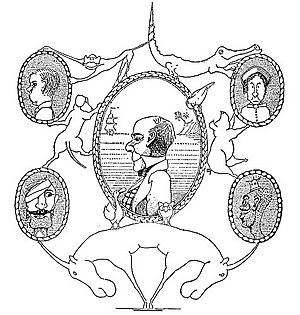Doctor Dolittle facts for kids
Quick facts for kids Doctor Dolittle |
|
|---|---|

Portrait from title page of The Story of Doctor Dolittle
|
|
| First appearance | The Story of Doctor Dolittle |
| Created by | Hugh Lofting |
| Portrayed by |
|
| Voiced by | Bob Holt {1970} |
| Information | |
| Aliases | King Jong Thinkalot |
| Gender | Male |
| Occupation | Doctor, naturalist |
| Family | Lisa Dolittle (wife, 1998 series) Charisse Dolittle (daughter, 1998 series) Maya Dolittle (daughter, 1998 series) Lily Dolittle (wife, 2020 series) |
| Relatives | Sarah Dolittle (sister) Archer Dolittle (father, 1998 series) |
| Nationality | British American (1998–2001) |
Doctor John Dolittle is a super cool character from a series of children's books by Hugh Lofting. The first book, The Story of Doctor Dolittle, came out in 1920. Doctor Dolittle is a special kind of doctor. Instead of helping people, he prefers to help animals! That's because he can talk to them in their own languages. How cool is that?
He later becomes a naturalist, which means he studies nature. He uses his amazing ability to talk with animals to learn more about the world and its history.
Doctor Dolittle first appeared in letters that author Hugh Lofting wrote to his children. He wrote these letters from the trenches during World War I. He said that real news was either too scary or too boring, so he made up these fun stories instead. The stories take place in early Victorian England. Doctor Dolittle lives in a made-up English village called Puddleby-on-the-Marsh.
Doctor Dolittle has a few human friends, like Tommy Stubbins and Matthew Mugg. But his best friends are his animal companions! These include Polynesia (a smart parrot), Gub-Gub (a pig), Jip (a loyal dog), Dab-Dab (a goose), Chee-Chee (a funny monkey), Too-Too (an owl), and the amazing Pushmi-pullyu. He also has a white mouse named Whitey. Later, Whitey even starts a "Rat and Mouse Club" with the doctor's help!
Contents
Who Inspired Doctor Dolittle?
One person who might have inspired the character of Doctor Dolittle is a Scottish surgeon named John Hunter.
The Amazing Books
The first book, The Story of Doctor Dolittle, came out in 1920. It tells you all about his strange life at home and his exciting adventures in faraway places. The next book, The Voyages of Doctor Dolittle (1922), was so good that it won a famous award called the Newbery Medal.
Hugh Lofting wrote many more adventures about Doctor Dolittle. Here are some of the main books in the series, listed by when they were published:
- The Story of Doctor Dolittle (1920)
- The Voyages of Doctor Dolittle (1922)
- Doctor Dolittle's Post Office (1923)
- Doctor Dolittle's Circus (1924)
- Doctor Dolittle's Zoo (1925)
- Doctor Dolittle's Caravan (1926)
- Doctor Dolittle's Garden (1927)
- Doctor Dolittle in the Moon (1928)
- Doctor Dolittle's Return (1933)
- Doctor Dolittle and the Secret Lake (published in 1948)
- Doctor Dolittle and the Green Canary (1950)
- Doctor Dolittle's Puddleby Adventures (1952)
There are also some shorter stories and special books like Gub Gub's Book: An Encyclopaedia of Food (1932). This book is supposedly written by Gub-Gub the pig! It's full of fun facts about food from an animal's point of view.
Doctor Dolittle's Adventures in Order
The books weren't always published in the same order that the stories happen. Here's a list of the main stories in the order they actually happen in Doctor Dolittle's life:
- The Story of Doctor Dolittle (1920)
- Doctor Dolittle's Circus (1924)
- Doctor Dolittle's Caravan (1926)
- Doctor Dolittle and the Green Canary (1950)
- Doctor Dolittle's Post Office (1923)
- The Voyages of Doctor Dolittle (1922)
- Doctor Dolittle's Zoo (1925)
- Doctor Dolittle's Garden (1927)
- Gub Gub's Book: An Encyclopaedia of Food (1932)
- Doctor Dolittle in the Moon (1928)
- Doctor Dolittle's Return (1933)
- Doctor Dolittle and the Secret Lake (1948)
Doctor Dolittle in Movies and Shows
The Doctor Dolittle stories have been made into many different movies, TV shows, and even stage plays!
Animated Shows and Movies
- 1928: Doktor Dolittle und seine Tiere (Doctor Dolittle and his Animals), a silent animated short film from Germany.
- 1970–1972: A Doctor Dolittle animated TV series.
- 1984: The Voyages of Doctor Dolittle, a cartoon made by the U.S. and Japan together.
- 2011: The Voyages of Young Doctor Dolittle, an animated movie that went straight to video.
Audio Stories
- 1933–1934: A radio series on NBC.
- 1995–2001: BBC audio books read by the famous actor Alan Bennett.
Stage Musicals
- 1973: A stage show by the Philadelphia Boys Choir & Chorale.
- 1998: A musical called Doctor Dolittle, based on the 1967 movie.
- 2007: Another stage musical by TheatreWorksUSA.
Live-Action Films
- 1967: Doctor Dolittle, starring Rex Harrison as the doctor.
- 1998: Dr. Dolittle and its sequels. In these movies, Eddie Murphy plays Doctor Dolittle. His daughter Maya, played by Kyla Pratt, is also a big part of the story. Their dog, Lucky, is voiced by Norm Macdonald.
- 2020: Dolittle, a new movie starring Robert Downey Jr. as Doctor Dolittle.
Video Games
- 2006: A Dr. Dolittle PS2 video game.
Doctor Dolittle Around the World
The stories of Doctor Dolittle have inspired writers and artists in other countries too!
- A Russian children's novel called Doctor Aybolit (which means "Doctor Oh-it-hurts") by Korney Chukovsky was based on Doctor Dolittle.
- A Norwegian artist named Thorbjørn Egner made an album called Doktor Dyregod (Doctor good-toward-animals) with songs and stories inspired by Doctor Dolittle.
- The books have been translated into many languages, including Japanese and Lithuanian.
See also
 In Spanish: Doctor Dolittle (personaje) para niños
In Spanish: Doctor Dolittle (personaje) para niños


